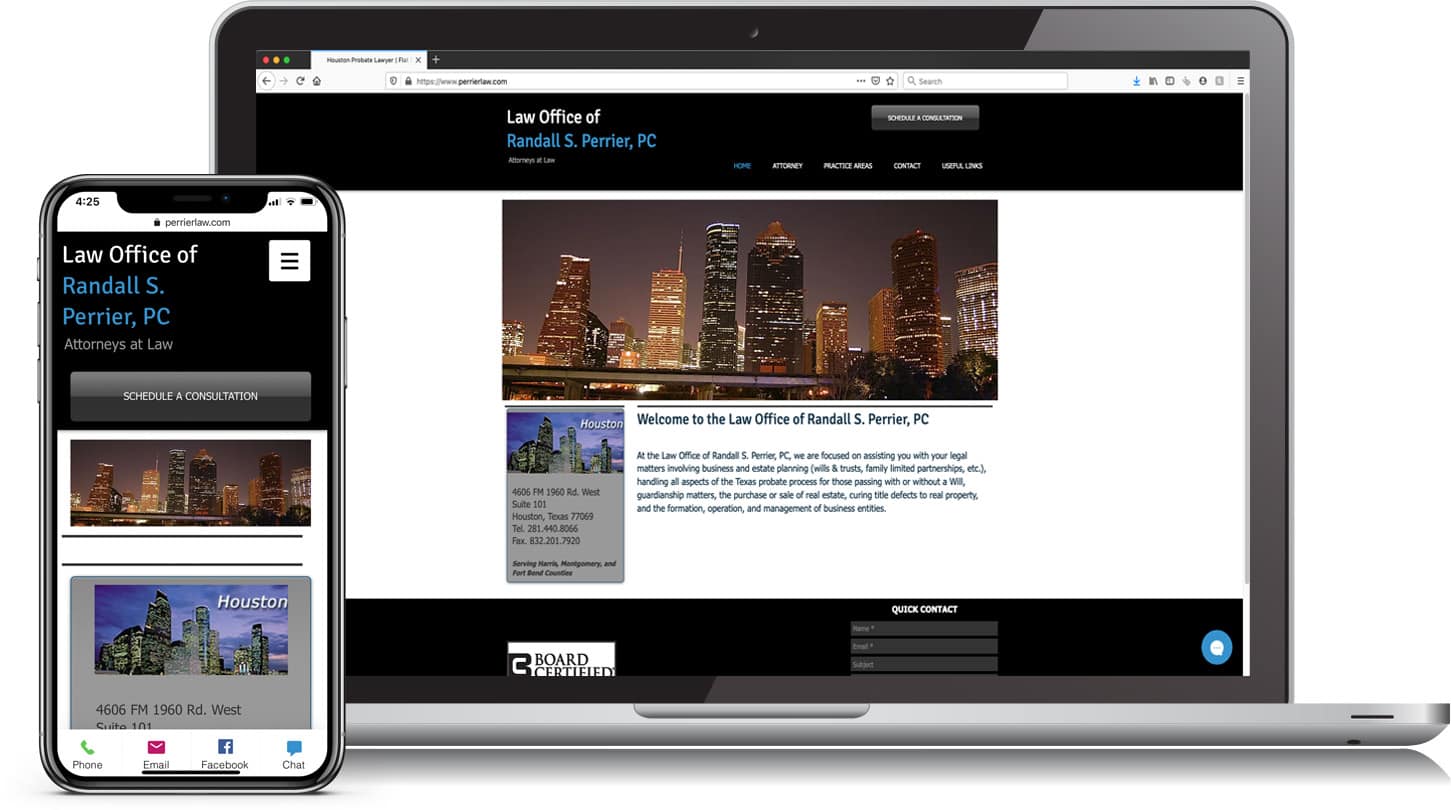Even today, in 2024, the vast majority of law firm websites fail to produce any meaningful or measurable results.
In this post, we reveal the two simple reasons your law firm’s website isn’t brining in any new clients and how you can fix it. It contains actionable information that you can put into place immediately to start getting more of the clients you want for your legal practice or law firm.


BEFORE
AFTER
A website can be an attorney’s most valuable marketing tool. But even today, in 2023, the vast majority of law firm websites fail to produce any meaningful or measurable results.
This is because most attorneys fail to maximize the potential of their websites, often treating them as mere digital brochures. These websites offer limited value, providing information that most prospective clients are uninterested in.
Rather than building a website for the sake of having one, attorneys should instead develop a clear purpose for their online presence. The goal should be to attract prospective clients and convert them into paying clients. To achieve this, there are two simple things your website must do:
1. Be easily discoverable by potential clients who are seeking solutions to their legal issue.
2. Persuade website visitors that your law firm is the ideal solution to their legal issue.
That’s it. If you accomplish those two things, you will have a consistent stream of prospective clients contacting your law firm. As simple as that may sound, the majority of attorneys struggle to implement both of these elements effectively, resulting in wasted marketing dollars and no new clients.
Many times attorney’s will get one of these elements right without the other. But it’s easy to see how that won’t produce results (new clients). If you are paying to drive traffic to a bad website, it won’t convert. If you have a great website, but no traffic, again no new clients. You must have both elements to start getting new clients from the internet.
Many attorneys then turn their back on digital marketing, believing that it is all hype and that it doesn’t work when in reality, nothing could be further from the truth.
To beat your competitors and market your law firm successfully online, law firms need a comprehensive digital marketing strategy that incorporates both of these elements.
By ensuring your website is discoverable and persuasive, you can start to generate new clients on autopilot.
Element 1: Building Your Website So That It Will Be Found Online
Many attorneys make the mistake of building a website without first devising a traffic strategy. The belief that simply building a website will automatically attract new clients and drive business growth is a common misconception. In reality, having a website is just the first step in establishing your law firm’s online presence.
To effectively generate traffic and start getting new clients, your website must be easily found when prospective clients are searching for solutions to their legal problems. This is where search engine optimization (SEO), pay-per-click (PPC) advertising, and other traffic-driving methods become critical.
3 Main Website Traffic Sources:
1. Organic Search Traffic
This refers to traffic that comes from search engines such as Google, Bing, or Yahoo. When a user enters a query into a search engine, the search engine provides a list of results that match the user’s query. If a website appears on this list and the user clicks on the link to visit the site, this is considered organic traffic.
Unfortunately your website will almost never rank on the first page of Google on its own with no intentional effort. In order to have your website rank on the first page of search engines so that it can be found by prospective clients, there are certain things that need to be done. This is where search engine optimization (SEO) comes in.
Search engines, such as Google, use complex algorithms to rank websites based on their relevance and usefulness to users’ search queries. SEO is the process of optimizing your website’s content and structure to improve its visibility in search engine results. This involves using relevant keywords, providing valuable content, ensuring mobile-friendliness, improving website loading speed, and acquiring quality backlinks, among other techniques.
2. Paid Search Traffic
PPC, or Pay-Per-Click, is a digital marketing model where advertisers pay a fee each time their ads are clicked by users. It’s a way of buying visits to a website, rather than attempting to earn them organically through search engine optimization (SEO). One of the most popular PPC advertising platforms is Google Ads, which allows advertisers to bid for ad placements on the Google search results page.
To make the most of PPC advertising for lawyers, attorneys should focus on optimizing their campaigns by selecting the right keywords, creating compelling ad copy, and designing effective landing pages that encourage users to take action (e.g., call, schedule a consultation, or fill out a contact form).
PPC marketing offers attorneys a valuable tool for getting their websites discovered by potential clients. By providing immediate visibility to people looking for solutions to a legal problem they can help with and offering measurable results, PPC campaigns can very efficiently drive relevant traffic to an attorney’s website generating new leads and new clients.
3. Social Media Traffic
Social media marketing (SMM) is the process of promoting your legal practice through various social media platforms, such as Facebook, Twitter, LinkedIn, Instagram, and others. The primary goal of SMM is to create engaging content that resonates with your prospective clients, encourages them to share and interact with the content, and ultimately increase brand awareness while driving traffic to your website.
While the first two traffic sources are more search intent focused (meaning the visitor is actively searching for solutions to a legal problem) and therefore will produce new clients more often at a higher rate, social media marketing can still produce valuable website traffic. By choosing the most appropriate platforms for your target audience, creating engaging and valuable content, and interact with your followers, lawyers can attract more targeted visitors to their website, increasing their overall online presence.
Traffic Summary
By optimizing your website for search engines and actively promoting it through various channels such as PPC and social media, you can increase your website’s visibility and drive prospective clients to it.
Understanding that your website will not automatically start getting visitor traffic just because it exists is key here.
Having a solid traffic strategy in place before you build your website will ensure your website produces measurable and meaningful results (i.e. new clients). Without a solid traffic strategy in place, your website will likely remain unnoticed and fail to bring in any new clients.
Element 2: Building Your Website So That It Will Convert Prospects into Paying Clients
You can drive all the traffic in the world to your website, but if the website lacks fundamental elements, you’ll likely convert little to none of that traffic and have very little to show for it at the end of the day.
This is often the main reasons many lawyers and law firms believe that SEO and PPC marketing doesn’t work. If you’re sending good traffic to a bad website, it won’t convert (and those clicks can be expensive!) For this reason, it’s imperative that your website be built to convert prospects into paying clients before you ever spend any money on getting website traffic.
4 Key Website Elements to Convert Prospective Clients into Paying Clients:
1. Modern, Professional, and Simple Design
A well-designed website is crucial in conveying the right message to your prospective clients. Focus on creating a clean, modern, and user-friendly website that sets you apart from competitors. Ensure that your website is mobile-optimized and displays content clearly on all devices as users respond better to sites that work seamlessly on smartphones, tablets, and PCs.
Avoid using complex features such as Flash videos, sliders, or memory-consuming content, as these rarely improve conversion rates and can negatively impact user experience. Pay attention to technical SEO and website architecture to optimize your site for search engines. A fast-loading website can boost search engine rankings and user engagement. Use tools like Google’s PageSpeed Insights to evaluate your website’s performance and make improvements.
2. Speaks to Your Ideal Clients
To effectively communicate the value of your legal services, put yourself in your ideal client’s shoes. Your website should quickly convey your message in a clear, enticing, and memorable manner. Develop a comprehensive content strategy and write sales copy that highlights your unique selling points, addresses client’s frequently asked questions, and showcases your expertise.
Also, having a website that only advertises one or two areas of practice has shown to improve conversion rates. This is because people tend to seek out a “specialist” when looking to solve a legal problem. By focusing on designing your website to cater specifically to just one or two target practice areas, it can give you an advantage in search engine rankings and has been shown to create an impression of expertise and specialization in potential clients’ minds without you having to say so.
3. Builds Trust
Your website should reflect your legal practice’s professionalism and credibility. Consistent branding, including logo and color schemes can help establish trust with your prospective clients and improve conversion rates. You should display client testimonials easily by using tools to embed online reviews from sources like Google and Facebook. Also, showcase any awards, recognitions, or special certifications or specializations that can bolster your credibility and expertise.
Personal touches such as your photo and images that reflect your practice area(s) and geographic service location can make your website more approachable and relatable. These elements can subconsciously help prospective clients come to the conclusion that they should hire you to help them with their legal problem(s).
4. Encourage Action
Implement clear and compelling calls-to-action (CTAs) throughout your website to guide users to contact your law firm. Effective CTAs should have strong visuals, create a sense of urgency, eliminate objections or friction, and be easily accessible. By making it easy for prospects to know how to contact your firm, you increase the chances of converting them into paying clients. Ensure that mobile versions of your website include features like “click-to-call” buttons and straightforward contact forms to optimize the user experience and encourage engagement.
Conclusion
Many attorneys and law firms have websites that fail to effectively resonate with their prospective clients, creating a significant opportunity for those who do. Instead of merely following the crowd, create a website with a clear purpose: to attract and convert your ideal prospects into paying clients.
By having a solid traffic strategy in place and incorporating the four key elements outlined above into your law firm or legal practice’s website design, you can distinguish yourself from your competitors and start getting new clients from your website.
By embracing the concepts in this post, you can build a website that starts to produce meaningful and measurable results, helping you to grow your law firm or legal practice at the pace that you want.
About the Author
Chris is a legal marketing consultant who has been helping attorneys and law firms grow their revenue and scale their legal practices for the past 13 years. His areas of expertise are in content marketing, search engine optimization (SEO), pay-per-click (PPC), digital PR & branding, and conversion rate optimization (CRO).








